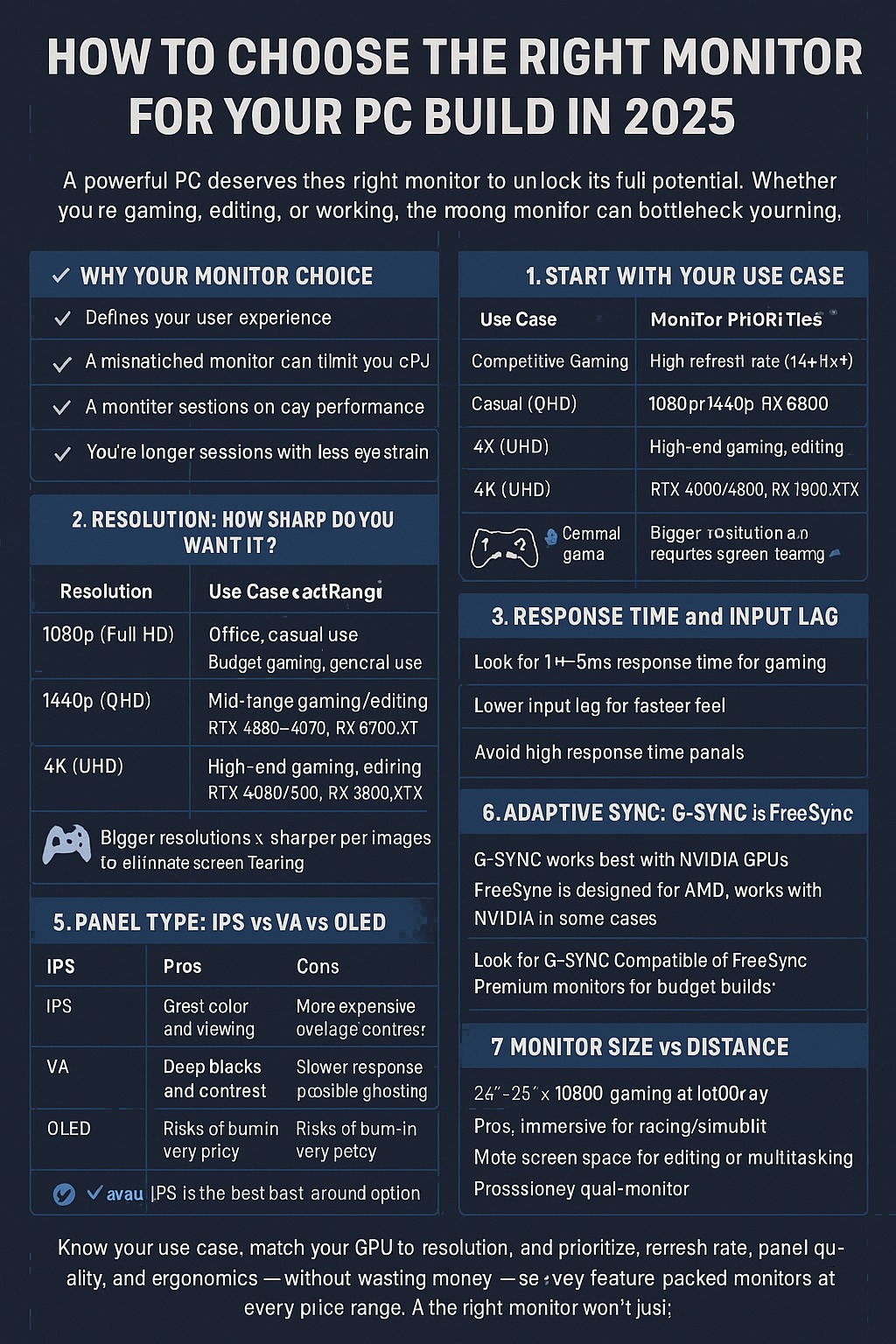A powerful PC deserves the right monitor to unlock its full potential. Whether you’re gaming, editing, or working, the wrong display can bottleneck your experience.
In this guide, you’ll learn how to choose the best monitor for your build — based on refresh rate, resolution, panel type, and key features — without wasting money.
Why Your Monitor Choice Matters
✅ Your monitor defines your user experience
✅ A mismatched monitor can limit your GPU’s performance
✅ The right display improves clarity, color, and responsiveness
✅ You’ll enjoy longer sessions with less eye strain
1. Start With Your Use Case
| Use Case | Monitor Priorities |
|---|---|
| Competitive Gaming | High refresh rate (144Hz+), low response |
| Casual Gaming | 1080p/1440p, 75–144Hz, decent colors |
| Content Creation | Color accuracy, 4K, IPS panel |
| Productivity & Coding | Larger size, ultrawide, text clarity |
| Mixed Use (all-around) | Balanced resolution and refresh rate |
2. Resolution: How Sharp Do You Want It?
| Resolution | Use Case | GPU Requirement (2025) |
|---|---|---|
| 1080p (Full HD) | Budget gaming, general use | GTX 1660, RTX 3050, RX 6600 |
| 1440p (QHD) | Mid-range gaming/editing | RTX 4060–4070, RX 6700 XT |
| 4K (UHD) | High-end gaming, editing | RTX 4080/4090, RX 7900 XTX |
💡 Bigger resolutions = sharper images, but require more GPU power
3. Refresh Rate: Smoothness Matters
| Refresh Rate | Ideal For |
|---|---|
| 60Hz | Office, casual use |
| 75Hz | Budget gaming, general use |
| 144Hz | Competitive/mid-tier gaming |
| 240Hz+ | High-end FPS and eSports setups |
🎮 Combine with G-SYNC or FreeSync to eliminate screen tearing
4. Panel Type: IPS vs VA vs OLED
| Panel Type | Pros | Cons |
|---|---|---|
| IPS | Great color and viewing angles | More expensive, average contrast |
| VA | Deep blacks and contrast | Slower response, ghosting possible |
| OLED | Incredible colors, instant response | Risk of burn-in, very pricey |
| TN | Cheap, low input lag | Poor color and viewing angles |
✅ For most users, IPS is the best all-around option
5. Response Time and Input Lag
- Look for 1ms to 5ms response time for gaming
- Lower input lag = snappier feel (especially in shooters)
- Avoid high response time panels for fast-paced games
6. Adaptive Sync: G-SYNC vs FreeSync
- G-SYNC = works best with NVIDIA GPUs
- FreeSync = designed for AMD, works with NVIDIA in some cases
- Prevents screen tearing and stuttering
Look for G-SYNC Compatible or FreeSync Premium monitors for budget builds
7. Monitor Size vs Distance
| Size (inches) | Recommended Use & Distance |
|---|---|
| 24″–25″ | 1080p gaming at short range |
| 27″ | Best for 1440p |
| 32″ | Productivity or 1440p/4K |
| 34″+ (Ultrawide) | Multitasking, racing games |
💡 For gaming, 24–27″ at 1080p or 1440p is the sweet spot
8. Ultrawide and Curved Monitors
Pros:
- Immersive for racing/simulation games
- More screen space for editing or multitasking
- Replaces dual-monitor setups
Cons:
- More expensive
- Not all games support 21:9 properly
- Higher GPU load
9. Color Accuracy and HDR
- Content creators need 100% sRGB or AdobeRGB coverage
- HDR is improving, but only true HDR600+ makes a difference
- Look for DisplayHDR certified if you care about brightness & contrast
10. Top Monitor Brands in 2025
- LG (UltraGear, Ultrawide, OLED)
- ASUS (ROG Swift, TUF Gaming)
- Acer (Predator, Nitro)
- Gigabyte/AORUS
- Dell/Alienware
- Samsung (Odyssey line)
Choose brands with strong warranties and pixel return policies
Final Thoughts
A good monitor enhances every aspect of your PC build — from competitive gaming to creative work. In 2025, you can find feature-packed monitors at every price range.
Know your use case, match your GPU to your resolution, and prioritize refresh rate, panel quality, and ergonomics. The right monitor won’t just look good — it’ll make everything feel better.
